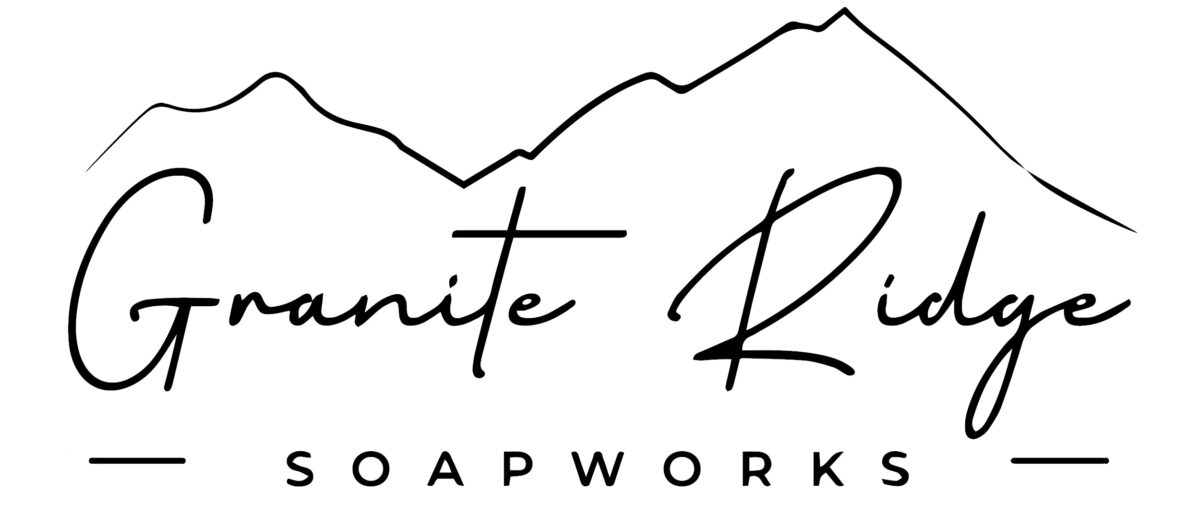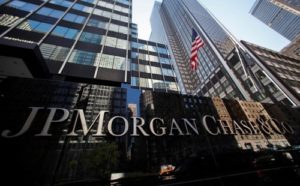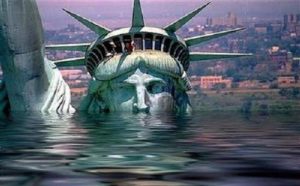
By Pam Martens and Russ Martens:
The widely respected banking and Wall Street watchdog, Better Markets, has a new report out on the latest teetering bank holding company, New York Community Bancorp (ticker NYCB). The title of the well-researched report pretty much says it all: “A Frankenstein Monster Federal Regulators Created.”
NYCB has lost 65 percent of its stock market value year-to-date and was downgraded to a junk credit rating by Moody’s after the stock market closed on February 6. Moody’s wrote in its downgrade that a third of the bank’s deposits lack FDIC insurance.
NYCB’s rapid share price descent began on January 31 when the bank filed an 8K form with the SEC indicating a $260 million net income loss in the fourth quarter; a dividend cut from 17 cents to 5 cents; and a $552 million provision for credit losses on commercial real estate – an area of growing concern by the credit rating agencies.
The facts in the Better Markets report are astonishing in terms of what passes for federal bank regulation today. The Better Markets researchers write as follows:
“In late 2022 and early 2023, the federal banking regulators inexplicably approved not one, but two, mergers for NYC Bancorp in rapid succession. First, in December 2022, Flagstar was acquired by NYC Bancorp and at the same time Flagstar acquired [New York Community Bank]. Then, only about 100 days later, Flagstar was selected as the winning bidder by the FDIC to acquire the failed Signature Bank (‘Signature’). A bank acquiring and integrating any one of these transactions in isolation would be challenging under the best of circumstances, it is inexplicable that the banking regulators allowed them in tandem under extremely stressed conditions.”
And this:
“…over the course of just two quarters, Flagstar’s two acquisitions quadrupled its asset size, from $25 billion on September 30, 2022, to $123 billion on March 31, 2023. It also more than doubled its employee count, from about 2,800 in September 2022 to 6,800 in March 2023.”
It should be noted that rapid asset growth was cited by federal banking regulators as a key factor in the collapse of Silicon Valley Bank, which set off a banking panic and bank runs in the spring of last year. That panic resulted in the second, third and fourth largest bank failures in U.S. history.
The Better Markets investigation points the finger at the federal regulator of national banks, the Office of the Comptroller of the Currency (OCC), as a key player in the making of this Frankenstein bank. (National banks are those allowed to operate across state lines.)
What happened was that when this bank didn’t initially get merger approval from its primary federal regulator, it simply switched its primary regulator to the OCC and got its merger approved.
Better Markets calls this “shocking and literally unbelievable,” writing as follows:
“…The American people rely on the banking regulators to protect them, and the broader financial system and the facts related to this situation suggest unacceptable failures in these areas.
“The apparent lack of regulatory coordination and the ability of a bank to switch regulators and receive a different decision on a merger application is shocking and literally unbelievable. However, what is worse is the apparent willingness of regulators to overlook all that and racial discriminatory conduct by merger participants on multiple occasions in approving the final merger transaction. The American people deserve better from their financial regulators, and financial stability depends on it.”
The grimy fingerprints of the OCC were also at play when it approved the purchase of the failed First Republic Bank by the riskiest and largest bank in the United States – JPMorgan Chase – on May 1 of last year.
On July 12 of last year, Senator Elizabeth Warren, Chair of the Senate Banking’s Subcommittee on Economic Policy, held a hearing on “Bank Mergers and the Economic Impacts of Consolidation.” Warren had this to say during the hearing:
“When First Republic Bank collapsed in April, the bank was ultimately sold to the biggest bank in America, JP Morgan Chase. That sweetheart deal cost the Federal Deposit Insurance Fund $13 billion. Meanwhile, overnight, the country’s biggest bank got $200 billion bigger. And what happened to the regulators? The Acting Comptroller of the Currency, Michael Hsu, rubber stamped the deal in record time. When I asked Mr. Hsu at a hearing in May to explain how this merger was approved, he was unable to provide a clear answer.
“But the overall picture gets worse. Instead of inattentive regulators who don’t use their tools to block increasing consolidation, leaders within the Biden Administration seem to be inviting more mergers. In a May 2023 statement before the House Financial Services Committee, Acting Comptroller Hsu reassured banks that the agency would be ‘open-minded’ while considering merger proposals….
“Treasury Secretary Yellen recently warned that the banking ‘turmoil’ from the collapse of Silicon Valley Bank, Signature Bank, and First Republic might lead to more mergers and that regulators would be – quote – ‘open to’ them. Then the New York Times also reported that Secretary Yellen privately told big banks that she would, and I quote, ‘welcome more mergers.’ ”
At the hearing, Warren called this lax position by regulators to be “stunningly wrongheaded” and “courting disaster.”
Tens of millions of Americans are sleepwalking their way to the next banking crisis. If you agree with Wall Street On Parade that the current banking structure in the U.S. represents a threat to national security and economic stability, please contact your U.S. Senators today via the U.S. Capitol switchboard by dialing (202) 224-3121. Tell your Senators to hold immediate hearings on the Fed’s non-stop bailouts of the banking sector and demand the restoration of the Glass-Steagall Act to separate Wall Street’s trading casinos from federally-insured commercial banks.


Give the gift of great skin care. Our Soap and Shave Bars are gentle and produce a smooth creamy lather that is nourishing to your skin. They are handmade in small batches. We use only high-quality natural ingredients that you can pronounce. No chemicals, no sodium laurel sulfate, no phthalates, no parabens, no detergents. The set can include Soap Bar, Shave Bar, Shave Brush, and/or Shampoo Bar. These come in a white box and are perfect for your gift giving needs.
Our soaps are made with skin loving ingredients including olive oil, coconut oil, lard, sweet almond oil, shea butter, and castor oil. We do not use palm oil. Scented only lightly with fragrance oils.
The Shave bars give a very close and smooth shave with no razor burn. They leave your skin feeling amazing. A lather can be built up in your hands and then applied to your face, but it is best to use a shaving brush. These bars will only produce a thick foam when used with a shaving brush.
Our Shampoo Bars have a thick lather. A lather can be built up in your hands and then applied to your hair, but it is best to rub the bar gently in your hair. Rinse and repeat.
You choose a scent:
A Thousand Dreams is a whimsical blue scented in a warm mix of fruity and floral notes with peach, peony, lily, musk, sandalwood, and amber.
Bay Rum Spice is a nice masculine scent similar to Old Spice. The scent notes are clove, pine needles, cedarwood, orange, vanilla, and musk.
Birch Woods is a great outdoors-type scent. The notes are bergamot, patchouli, vetiver, and tonka bean.
Cool Clear Water is a refreshing scent. The notes are crisp water, oakmoss, pine, cedar, and musk.
Lavender Champagne has a wonderful scent of Lavender and Champagne and has a light purple color. The scent notes are lavender, sparkling Champagne, grapefruit, orange, thyme, oak, and amber.
Midnight Waters is a moody-mystical scent that opens with fruity notes of red berries, juicy tangerine, and bergamot. Then unfolds into bubbly Champagne, violet flowers, cashmere, amber, and musk.
Raspberry Vanilla is an all-time favorite fragrance for soap. It is a beautiful magenta color. The scent notes are raspberry, strawberry, lemon, coconut, peach, honeysuckle, plum, and vanilla.
Warm Sandalwood is a warm, rich, and woodsy scent. The colors are warm and rich with brown, gold, and white.
A Soap bar will weigh approximately 4 ounces and be approximately 2.25 inches wide by 3.5 inches tall and 1 inch thick. A Shave bar will weigh approximately 3 ounces and be approximately 2.5 inches across and 1.25 inches thick. A Shampoo Bar will weigh approximately 3.5 ounces and be approximately 2.5 inches across and 1.25 inches thick. Please keep in mind that our products are handmade and hand cut. Each bar is unique and might vary slightly in shape, size, design, and color from those pictured.
Please keep your Soap Bars, Shave Bars, and Shampoo Bars well-drained and allow to dry between uses. This will ensure longer lasting bars. www.graniteridgesoapworks.store
![]()





